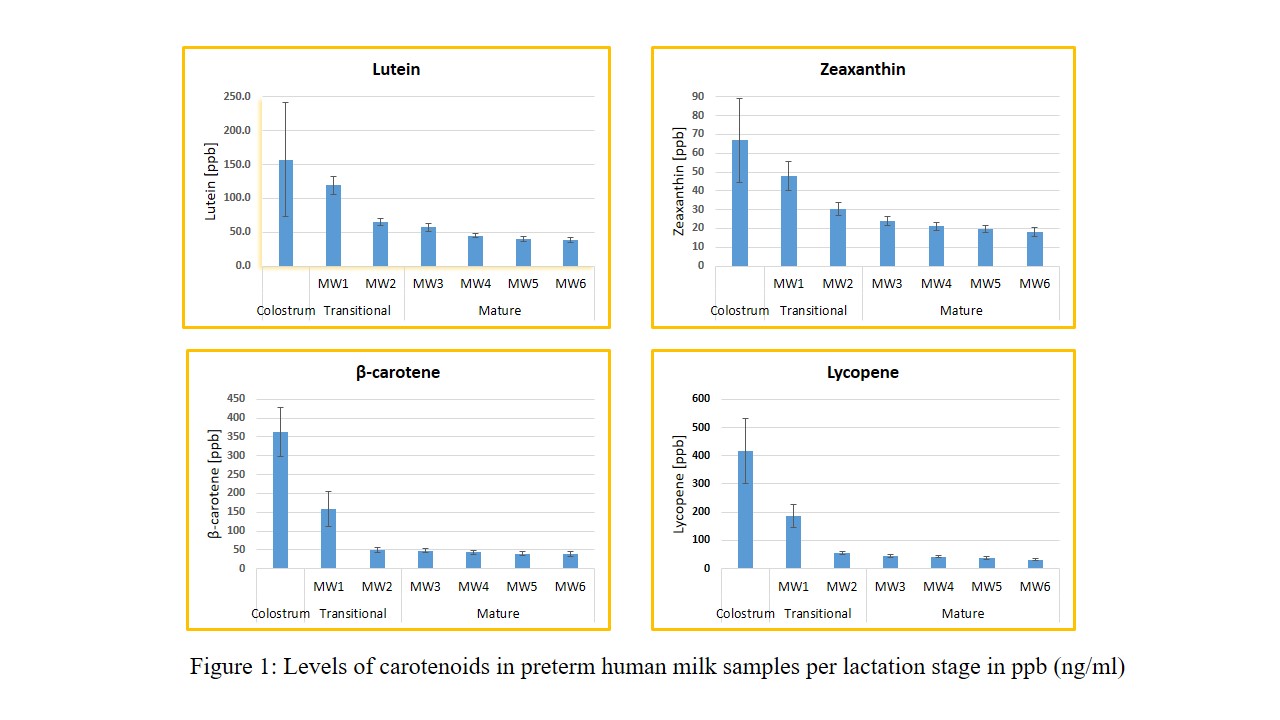Breastfeeding/Human Milk
Category: Abstract Submission
Breastfeeding/Human Milk II
432 - Lutein Concentrations in Preterm Human Milk and Retinopathy of Prematurity – a Prospective Observational Study
Sunday, April 24, 2022
3:30 PM - 6:00 PM US MT
Poster Number: 432
Publication Number: 432.302
Publication Number: 432.302
Adi Uretzky, Ichilov hospital, Tel aviv, Tel Aviv, Israel; Laurence Mangel, Tel Aviv Medical Center, Tel Aviv, Tel Aviv, Israel; Dror Mandel, Dana Children's Hospital, Tel Aviv Medical Center, Tel Aviv, Tel Aviv, Israel; Anat Schwartz, Tel Aviv Sourasky Medical Center (Ichilov), Tel aviv, Tel Aviv, Israel; Kira Kaganov, Ichilov, Tel aviv, Tel Aviv, Israel; Esther Buchman, Tel Aviv sourasky medical center, Netanya, HaMerkaz, Israel; Jenny Feldman, TEL AVIV MEDICAL CENTER, Tel Aviv, Tel Aviv, Israel; Adi Balter, start up company, Haifa, HaZafon, Israel; Yatreb Odetallh, IFF, Kfar Cana, HaZafon, Israel; Ronit Lubetzky, Tel Aviv Medical Center, Tel Aviv, Tel Aviv, Israel

Ronit Lubetzky, MD (she/her/hers)
Director, Department of Pediatrics
Dana Dwek Children's Hospital, Tel Aviv Medical Center
Tel Aviv, Tel Aviv, Israel
Presenting Author(s)
Background: Retinopathy of prematurity (ROP) is a retinal neovascular disorder affecting preterm infants (PTI) and constitutes a major cause of visual impairment and blindness. Oxidative damage by oxygen free radicals has been identified as the key factor in the pathogenesis process. Lutein is one of two major carotenoids found as a color pigment in the human eye (macula and retina). It is thought to have a protective role against oxidative and light damage. Lutein is supplied to the preterm infant by human milk (HM) via the maternal diet.
Little is known on the link between lutein content of preterm HM and ROP.
Objective: We conducted a prospective observational study to investigate the correlation between levels of lutein in HM and the occurrence and severity of ROP in preterm infants. We performed a longitudinal analysis of four carotenoids: Lutein, Zeaxanthin, Beta-Carotene and Lycopene in preterm HM.
Design/Methods: Healthy exclusively lactating mothers of preterm infants born at gestational age 24+2 weeks to 29+6 weeks or with birth weight under 1500 grams were recruited. Each participant provided up to 7 HM samples of 2-10 ml at day 0-3 (Colostrum) and once a week (+/- 2 days) until 6 weeks post delivery. In addition, a plasma sample was prepared from an aliquot of 1 ml blood collected from the infant at week 6 during NICU routine blood test when available. Milk and plasma samples were stored frozen at -80°C, wrapped in aluminum foil to minimize light exposure, until analyzed by modified HPLC methodologies.
Results: Forty-five mothers of PTI were enrolled along with their infants at the Dana Children's Hospital of the Tel Aviv Medical Center between May 2018 and August 2020. Following the exclusion of six mothers, the remaining 39 mother-infant dyads generated a total of 184 HM samples and 22 plasma samples. Seven infants developed ROP. Lutein, zeaxanthin, beta-carotene and lycopene concentrations decreased as lactation progressed, being at their highest in colostrum samples, Figure 1. There were no correlations between lutein levels in HM samples at week 2 and 4 and ROP occurrence by Kendall's tau_b correlation (τb = .05, p = .757 and τb = .17, p = .276, respectively). By Pearson correlation, beta-carotene and lycopene levels in plasma samples correlated with those seen in human milk samples at week 6 (r (18) = .87, p < .001 and r (18) = .59, p = .006, respectively).Conclusion(s): No correlation was found between lutein content in preterm HM during the first 6 weeks of lactation and the occurrence of ROP.
Levels of Carotenoids in Preterm HM Samples per Lactation Stage Contents are presented as ppb (ng/ml)
Contents are presented as ppb (ng/ml)
Little is known on the link between lutein content of preterm HM and ROP.
Objective: We conducted a prospective observational study to investigate the correlation between levels of lutein in HM and the occurrence and severity of ROP in preterm infants. We performed a longitudinal analysis of four carotenoids: Lutein, Zeaxanthin, Beta-Carotene and Lycopene in preterm HM.
Design/Methods: Healthy exclusively lactating mothers of preterm infants born at gestational age 24+2 weeks to 29+6 weeks or with birth weight under 1500 grams were recruited. Each participant provided up to 7 HM samples of 2-10 ml at day 0-3 (Colostrum) and once a week (+/- 2 days) until 6 weeks post delivery. In addition, a plasma sample was prepared from an aliquot of 1 ml blood collected from the infant at week 6 during NICU routine blood test when available. Milk and plasma samples were stored frozen at -80°C, wrapped in aluminum foil to minimize light exposure, until analyzed by modified HPLC methodologies.
Results: Forty-five mothers of PTI were enrolled along with their infants at the Dana Children's Hospital of the Tel Aviv Medical Center between May 2018 and August 2020. Following the exclusion of six mothers, the remaining 39 mother-infant dyads generated a total of 184 HM samples and 22 plasma samples. Seven infants developed ROP. Lutein, zeaxanthin, beta-carotene and lycopene concentrations decreased as lactation progressed, being at their highest in colostrum samples, Figure 1. There were no correlations between lutein levels in HM samples at week 2 and 4 and ROP occurrence by Kendall's tau_b correlation (τb = .05, p = .757 and τb = .17, p = .276, respectively). By Pearson correlation, beta-carotene and lycopene levels in plasma samples correlated with those seen in human milk samples at week 6 (r (18) = .87, p < .001 and r (18) = .59, p = .006, respectively).Conclusion(s): No correlation was found between lutein content in preterm HM during the first 6 weeks of lactation and the occurrence of ROP.
Levels of Carotenoids in Preterm HM Samples per Lactation Stage
 Contents are presented as ppb (ng/ml)
Contents are presented as ppb (ng/ml)